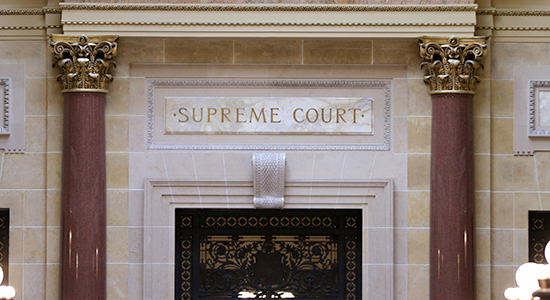
June 30, 2016 – Four people acquired real estate as tenants-in-common. One of them accumulated personal debt, including tax debt. Recently, the Wisconsin Supreme Court decided which judgment creditor would receive property sale proceeds, and how much.
In Prince Corp. v. Vandenberg, 2016 WI 49 (June 23, 2016), a Wisconsin Supreme Court majority (5-2) affirmed that the Wisconsin Department of Revenue (DOR) had a superior lien on the property, but could only garnish a portion of a final installment that the land purchaser was required to pay, not a portion of the full contract price.
The tenants-in-common, including Vandenberg, had argued that garnishment was limited to one-fourth of a final payment installment by the land purchasers, since two installments were already paid before the garnishment action commenced.
Thorny Issue
James Vandenberg, one of the tenants-in-common, owed the Wisconsin Department of Revenue (DOR) about $112,000. Prince Corporation obtained a money judgment against Vandenberg for $165,000, and the state obtained one for $100,000.
The next year, Vandenberg and the other tenants-in-common contracted to sell the property to Van De Hey Real Estate LLC for almost $342,000. The buyer knew that liens were attached to the land, based on Vandenberg’s debts.
Under the land contract, Van De Hey was to pay three installments of $113,900, and Vandenberg and the other owners were required to deliver a warranty deed free and clear of all encumbrances and liens. Van De Hey made the first two payments.
Then Prince Corp. filed a garnishment action against Van De Hey to garnish the final payment. The tenants-in-common intervened, arguing that the DOR had a superior lien interest, DOR did not file a garnishment action and, in any event, any garnishment award is limited to Vandenberg’s one-fourth share of the final payment.
The circuit court ruled that Prince Corp. was entitled to garnish one-fourth of the full contract price, $85,425, which represented Vandenberg’s one-fourth interest in the property. But Van De Hey delayed final payment pending the garnishment action.
The tenants-in-common then brought the DOR into the fold with a third-party complaint. They again argued that Price Corp.’s garnishment action should be dismissed, because DOR had an interest superior to Prince Corp. based on docketed income tax warrants.
And they argued that garnishment by any party, DOR included, is limited to one-fourth of the final payment, totaling about $28,500. The circuit court reconsidered, concluding that DOR was entitled to garnish $85,425 from Van De Hey’s final $113,900 payment.
 Joe Forward, Saint Louis Univ. School of Law 2010, is a legal writer for the State Bar of Wisconsin, Madison. He can be reached by email or by phone at (608) 250-6161.
Joe Forward, Saint Louis Univ. School of Law 2010, is a legal writer for the State Bar of Wisconsin, Madison. He can be reached by email or by phone at (608) 250-6161.
The circuit court also rejected the common tenants’ request for partition of the property so they could convey the property free and clear as required by the land contract. On appeal by Prince Corp. and the tenants-in-common, the court of appeals affirmed.
DOR Entitled to Garnishment
The majority assumed without deciding that Prince Corp. properly commenced the non-earnings garnishment action under Wis. Stats. Chapter 812, and also accepted that DOR was properly impleaded as a party to the already-commenced garnishment action. That is, the intervenors properly brought DOR in as an interested third party.
The intervenors did not argue that DOR was not a proper party (again, the intervenors brought DOR into the lawsuit), but they argued that statutory procedure still required DOR to file a non-earnings summons and complaint after being impleaded.
But the majority ruled that an impleaded third-party, under section 812.17, is not required to file a summons and complaint in an already-commenced action.
“We decline to impose a requirement that is plainly not required by the statute,” Chief Justice Patience Roggensack wrote for the majority. She noted that DOR filed an answer that incorporated Prince Corp.’s garnishment complaint.
“[T]he DOR’s answer sufficiently set forth its claim to [Vandenberg’s] interest in a portion of Van De Hey’s final land contract payment,” the chief justice wrote.
DOR Gets Portion of Final Payment Only
Unlike the lower courts, the majority ruled that DOR was only entitled to garnish one-fourth of the final land contract payment, not one-fourth of the full contract price.
“[C]ontrary to the court of appeals’ conclusion, a garnishor is entitled to garnish only the amount that the debtor could require be paid to him from the property in the hands of the garnishee when the garnishment is served,” Chief Justice Roggensack wrote.
Section 812.18 says, in part, that the garnishee shall be liable to the creditor for the property then in the garnishee's possession “from the time of service upon the grantee.”
“Moreover, well-established Wisconsin precedent provides that a garnishment action does not give the garnishor any greater rights in the property held by a third party than the debtor himself or herself possessed on the date that garnishment action was served,” Chief Justice Roggensack wrote.
The majority noted that Vandenberg, on the date the garnishment action was filed, was only entitled to one-fourth of the final land contract payment.
The court remanded the case for a factual determination on how much Vandenberg actually received from the first two payments, and what his final payment will be.
No Partition
The intervenors also argued that the land should be partitioned to allow the real estate to be sold free and clear of liens and encumbrances as required by the land contract. The majority ruled that the circuit court properly denied the request as prejudicial to one or more parties.
The majority noted that the common law of partition is codified by statute, “but petition remains an equitable action.” If the land was partitioned, Van De Hey could end up receiving three-fourths as unencumbered property, one-fourth as encumbered land.
“Partition would also result in reducing the security by three-fourths for others who have encumbrances on the real estate if their encumbrances were to remain only on [Vandenberg’s] 1/4 interest rather than on the undivided interests in the property,” wrote the chief justice, noting that judicial sale could also be prejudicial to other parties.
“[A]s Van De Hey contracted to purchase the entire property and made payments in furtherance thereof, public auction of the property would not result in Van De Hey receiving the benefit of its bargain” Chief Justice Roggensack noted.
Concurrence/Dissent
Justice Shirley Abrahamson, joined by Justice Ann Walsh Bradley, dissented in part and concurred in part. She said the majority “correctly decided the garnishment issues presented,” but its opinion still leaves the parties “in legal and financial limbo.”
On the issue of partition, Justice Abrahamson (and A.W. Bradley) dissented. The lower courts erred, she said, in concluding that partition would prejudice other parties.
She noted that even if Van De Hey pays the final installment, the land is still encumbered. “I would, in the absence of the parties’ settlement, remand the cause to the circuit court to consider whether to order partition by sale or any other equitable remedies necessary to untangle this thorny dispute,” Abrahamson wrote.
She said a partition hearing would allow all parties to be heard. At that point, the court could decide whether partition would be unfairly prejudicial to one or more parties.
